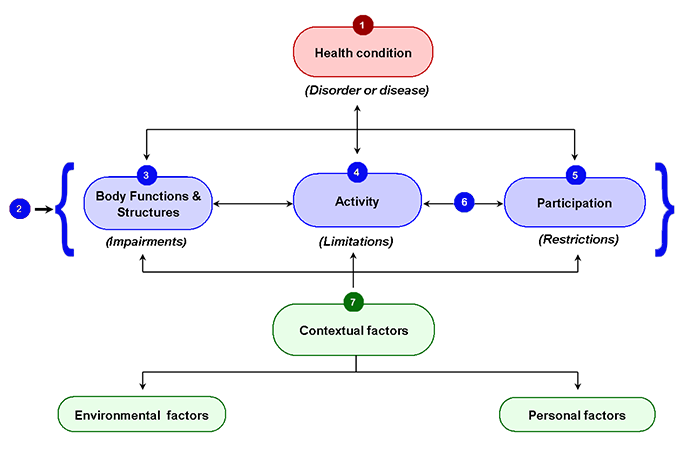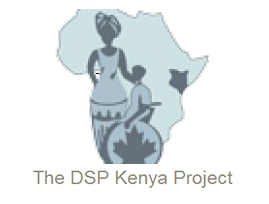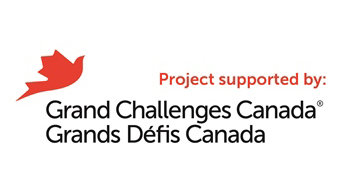1.3 – How can the World Health Organization’s “ICF” help us think about rehabilitation for people living with HIV?
The World Health Organization’s International Classification of Functioning, Disability and Health (known as the ICF)6 is helpful for thinking about the role of rehabilitation in HIV.7,8,9
Health conditions (the top box) are often the focus of HIV care and treatment, whereas the ICF calls attention to the wide range of the life-related challenges resulting from health conditions that can be addressed by rehabilitation (boxes 3-5).
The model was designed for all types of diseases and functioning, not just HIV. It offers a common language for clinicians, managers, policy makers or others interested in HIV models of care.
Figure 1.3: The ICF Model6

| The ICF Model (Figure 1.3) Explained | |
|---|---|
| 1 | This box describes the medical diagnoses, diseases or injuries that a person can experience. For a person living with HIV, this could be any combination of:
|
| 2 | This row describes the life-related impacts that result from health conditions. Rehabilitation addresses these impacts. |
| 3 | Impairments are problems in body function (physiological or psychological functions of body systems) or structure (anatomical body parts), e.g., weak abdominal muscles, memory loss, right-sided hypertonicity, congested lungs |
| 4 | Activity limitations are problems executing a task or action (e.g., getting dressed, walking to a clinic, carrying one’s child, communicating with a neighbor) |
| 5 | Participation restrictions are problems an individual may experience with involvement in life situations (e.g., being excluded from school, difficulty participating with one’s church, feeling stigmatized at work, challenges with parenting) |
| 6 | Note the arrows are bi-directional. This means that a challenge at one level can affect any other level. For example:
|
| 7 | Contextual factors influence or shape people’s experiences with these life-related impacts of health conditions.
|
6World Health Organization: International Classification of Functioning, Disability and Health (ICF) – Geneva. 2001. http://www.who.int/classifications/icf/en.
7Myezwa H, Buchalla C, Jelsma J, Stewart A. HIV/AIDS: use of the ICF in Brazil and South Africa – comparative data from four cross-sectional studies. Physiotherapy. 2011;97(1):17-25.
8Myezwa H, Stewart A, Musenge E, Nesara P. Assessment of HIV-positive in-patients using the International Classification of Functioning, Disability and Health (ICF), at Chris Hani Baragwanath Hospital, Johannesburg. AJAR. 2009;8(1):93-106. http://www.ajol.info/index.php/ajar/article/view/
42943.9Van As M, Myezwa H, Stewart A, Maleka D, Musenge E. The International Classification of Function Disability and Health (ICF) in adults visiting the HIV outpatient clinic at a regional hospital in Johannesburg, South Africa. AIDS Care. 2009;21(1):50-8. PubMed PMID: 19085220. http://www.ncbi.nlm.nih.gov/pubmed/19085220.
10World Health Organization, Commission on the Social Determinants of Health. Closing the gap within a generation: Health equity through action on the social determinants of health. Geneva: World Health Organization; 2008. http://www.who.int/social_determinants/final_report/csdh_finalreport_2008.pdf

 Previous Page
Previous Page




